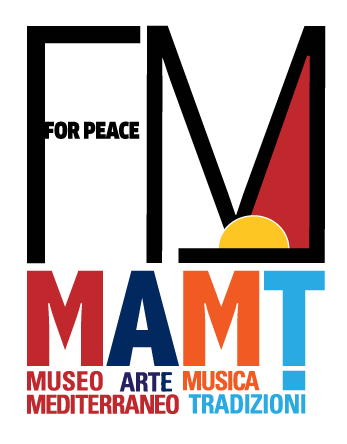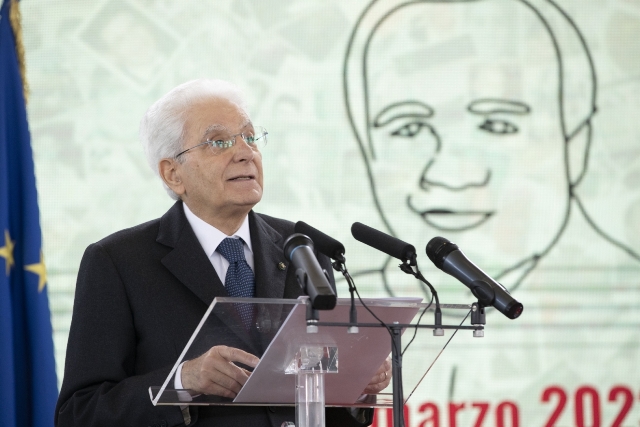
The MAMT- Mediterranean Museum of Art, Music and Traditions is an institution created by the Fondazione Mediterraneo with the aim “to experience” in an interactive way, the positive emotions of Our Sea through Arts, Music and Traditions. The MAMT is one of the most important initiatives of Fondazione Mediterraneo: an active space created in order to let communicate Arts, Music and Traditions of the Mediterranean contemporary society. The awareness of a past full of ancient traditions is the base for the construction of a rational and connected humanity: the vastness of the Mediterranean area collects together the responsibility, the hard work and intelligence with the ability to share spaces and cultures. Today, more than ever, the sense of future is given by the awareness of the sorrow, of the conflicts and at the same time by the ability to share joys and bond.
Art and Music are since ever the tool of communication and sharing of the humanity that, in a particular “Mediterranean” path, allows us to overtake the violence of the human being that showed itself in his greater brutality in countries as Bosnia, Palestine, Syria and other places: as testify of this there are Bosnia, in order not to forget and Suffering and Hope in the world, exhibitions of the museum.
At the same time there are symbols inviting to meeting and hope appear in lands of desolation and Hush: The Ferrigno Nativity Scene, the exhibition a Sea, three Faiths, the Peace and the Last Neapolitan Supper are part of the Museum.
Near the Totem of Peace and other works by Mario Molinari, sculptor of the color, accompanies the lonely journey of freedom, the Dreamlike World of John Crown and the desire of participation and recognition of the role of women in the Mediterranean in the exhibition “Breaking the Veils, women artists of Islamic World”.
Fado, Flamenco, Tango and Sirtaki, the Song of Naples, the Great Lyric Operas, Arabic Music and the Classics of all the times catch the attention of the audience with the acoustic perfection of the “Music hall” of the Museum.
The section dedicated to Pino Daniele has a particular meaning.
The warm of the Mediterranean human nature and the awareness of the necessity to keep track, the the wealth and the fertility find in the “Section Architecture” – with the Associated presences of Alvaro Siza, Ciamarra Picas, Vittorio Di Pace, Nicola Pagliara, Marco Introini and others - and in the Voices of the Migrants and other strong point.
The artworks of Pietro and Rino Volpe mark Mediterranean signs in which the culture and the literature merge with the creativity making a unique collection.
A collection of HD video about the most important sites of the Campania Region will accompany the tourists of cruises and the visitors in the whole building: the ground floor facing on Municipio Square will host an info-point unique in its kind. The MAMT is also an articulated system of services in the heart of the city of Naples: the library, the emeroteque, the music hall, salt conventions, the restaurants, the Euromedcafé, the residences and the bookshop receive the visitor with sympathy and enthusiasm: that enthusiasm of the Mediterranean!
 An exhibition of portraits of Tunisian women - in particular the ceramists of Sejnane, an intangible heritage of mankind, whose works are in the Museum in a special section - was hosted over the Easter period.
An exhibition of portraits of Tunisian women - in particular the ceramists of Sejnane, an intangible heritage of mankind, whose works are in the Museum in a special section - was hosted over the Easter period.





 A delegation from the Fondazione Mediterraneo with some visitors to the Museum of Peace led by President Michele Capasso took part in the Holy Mass and prayer ceremony for "Mary who loosens knots".
A delegation from the Fondazione Mediterraneo with some visitors to the Museum of Peace led by President Michele Capasso took part in the Holy Mass and prayer ceremony for "Mary who loosens knots". Students from the Liceo Sannazzaro in Naples visited the Museum of Peace MAMT, welcomed by Secretary General Michele Capasso, who explained the main emotional paths to the visitors.
Students from the Liceo Sannazzaro in Naples visited the Museum of Peace MAMT, welcomed by Secretary General Michele Capasso, who explained the main emotional paths to the visitors. Like every year, the Fondazione Mediterraneo celebrated "World Water Day" at the Museum of Peace MAMT.
Like every year, the Fondazione Mediterraneo celebrated "World Water Day" at the Museum of Peace MAMT. President of the Republic Sergio Mattarella celebrated the Memory Day and Commitment in remembrance of the victims of the Mafia in Casal di Principe, where Don Peppe Diana was assassinated by the Camorra on 19 March 1994.
President of the Republic Sergio Mattarella celebrated the Memory Day and Commitment in remembrance of the victims of the Mafia in Casal di Principe, where Don Peppe Diana was assassinated by the Camorra on 19 March 1994.